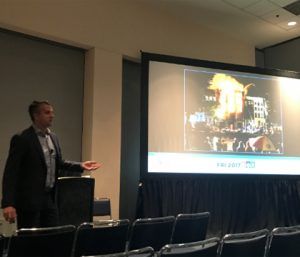 At the recent FRI 2017, firefighter Bart van Leeuwen presented on how smarter firefighters are enabled by better fire service data.
At the recent FRI 2017, firefighter Bart van Leeuwen presented on how smarter firefighters are enabled by better fire service data.
“If we don’t understand what we can do with data and embrace that – make our departments smarter – we will be disrupted and become obsolete,” he said.
His top three takeaways offer data strategies that can optimize fire service response:
#1 Understanding Outliers Challenge Machine Learning
A challenge to implementing data analysis in the fire department is the outlier. When he was starting out as a firefighter in the Netherlands, van Leeuwen’s mentor told him that his department never gets normal calls. He soon saw this for himself on his first few calls – one to a home where the owner had collected over 400 vacuum cleaners; another to a residence where the owners were awaiting their transport on the mothership, and were largely unconcerned with their kitchen fire.
Firefighters see these outliers all the time. How do you classify a car that’s flying down the interstate, takes the exit wide and crashes through the roof of a church? Is it an aerial extrication? An automobile accident? A structure collapse? When a plane crashes into a railway, do you call it a train accident or a plane crash? Classify one way, and responding crews will be surprised to find that the downed plane is located on a train track. Classify the other, and the arriving crews will be shocked to find a plane on the impacted railway. Without additional information, databases cannot identify who needs to respond, and with what information.
van Leeuwen’s end goal is to enable firefighters to connect all the dots of information available to them to attack these unique incidents.
#2 Integrating Digital Data Improves Structural Accessibility
On the other side of the coin, once the technology is trained to call up the right pieces of information, the benefits over paper procedures is clear.
van Leeuwen used the Anne Frank house as an example. There is a five-page preplan for a fire at this location, with a reference to a secondary SOP for a complex structure on the fifth page. He noted the first responding crew should access the preplan, find the correct page, then locate the referenced SOP to determine the preplan.
The challenge? Response times to the Anne Frank house averaged 57 seconds.
#3 Enabling Data Efficacy with Better Terminology
van Leeuwen asked the audience what they consider a smart firefighter. One attendee replied, “someone who thinks outside the box.” Van Leeuwen’s definition of the smart firefighter is that crewmember who can go to the truck, pull out a chainsaw, and while blindfolded, repair it behind their back. This firefighter could take all the tools available to the crew and tackle the rare incident, like the car in the church roof.
While machine learning, or data processing, can take hundreds of Excel sheets, manage the data and identify correlations and relationships, it needs to be educated about the outliers.
Spam filtering is an example of machine learning, or data analysis. It trains itself. You don’t get an email from your uncle in Nigeria who wants to leave you a multimillion dollar inheritance any more, because of spam filters, van Leeuwen noted.
What firefighters can do to enable smart data usage and data sharing is explain terminology. van Leeuwen discussed the differences in terminology between countries, regions, even departments. At the start of his presentation, when referencing a ladder truck and fire engine, he showed a picture to illustrate exactly what he was talking about. The first step in analyzing and implementing the information learned in big data is explaining our terminology, he noted.
When we start using digital technology to communicate, it assumes everyone uses the same terminology. A quick exercise revealed the very different terms different departments use, just within the confines of the session room:
- “Scalers” versus “roof ladder”
- “Water tankers” versus “water tenders”
- “Hang a plug” versus “hit the hydrant”
- “Hood tool” versus “Ray tool” (named for a firefighter who initiated its use in that department)
“Even in spoken language, we need to explain what we do. When it comes to digital data, are you sure that you understand what it means?” he asked. “Be sure what you do with the data is interchangeable.”












